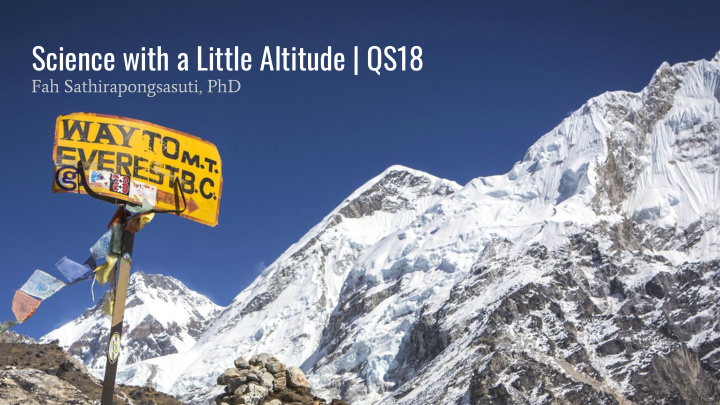



Science with a Little Altitude | QS18 Fah Sathirapongsasuti, PhD
EBC Everest
Day 1 Day 2 Day 3 Day 4 Day 5 Day 6 Day 7 Day 8 Day 8 Day 9 Day 10
Everest
Everest Everest Base Camp
Everest Everest Base Camp
Data Collection fitbit - Activities (elevation gain, step, calories) using Fitbit Charge HR - Peripheral capillary oxygen saturation (spO2) using iHealth Oximeter - Frequency: >5 times / day - Morning (wakeup) - At tea houses - On arrival at lodges - Before bed - Replicates: 3-5 replicates per measurement Oximeter
Data
Distance
Vertical climb
Calories
Effect of altitude on inhaled O2 (% of sea-level)
Effect of altitude on spO2
Altitude sickness was experienced when spO2 < 80% Headache, blurry vision, restless sleep
Effect of altitude on resting heart rate
Exercise decreases spO2 - High altitude exercise has long been observed to dramatically decrease spO2 [West et al 1962, West et al 1983, Pandolf and Burr 2002]
Rest, even a short one, can improve SpO2
Acclimatization markedly improves SpO2
Acclimatization markedly improves SpO2
Sherpas have higher spO2 Sherpa 89 vs Fah 85 Sherpa 88 vs Fah 85 Sherpa 96 vs Fah 93
Gut Microbiome at Genus Level 1 Week Before
Gut Microbiome at Genus Level 1 Week Before At Everest BC
Gut Microbiome at Genus Level 1 Week Before At Everest BC 3 Months After
Practical Advice Oximeter is unreliable on cold fingers or in bright light. ● Difficult to measure during the daytime ○ Best time to measure is before bed and right after waking up. ● Would be interesting to systematically measure SpO2 of Sherpa and other ● travellers for comparison. read more at https://blog.23andme.com/health-traits/science-little-altitude/
Acknowledgement Mio Sakata (partner) Jangbu Sherpa (guide) Nima Sherpa (porter) Rajendra Lamichhane (Green Valley Nepal Treks) Dr. Stephen Ruoss (Stanford Med., Pulmonology) Steven Jonas (QS)
Recommend
More recommend